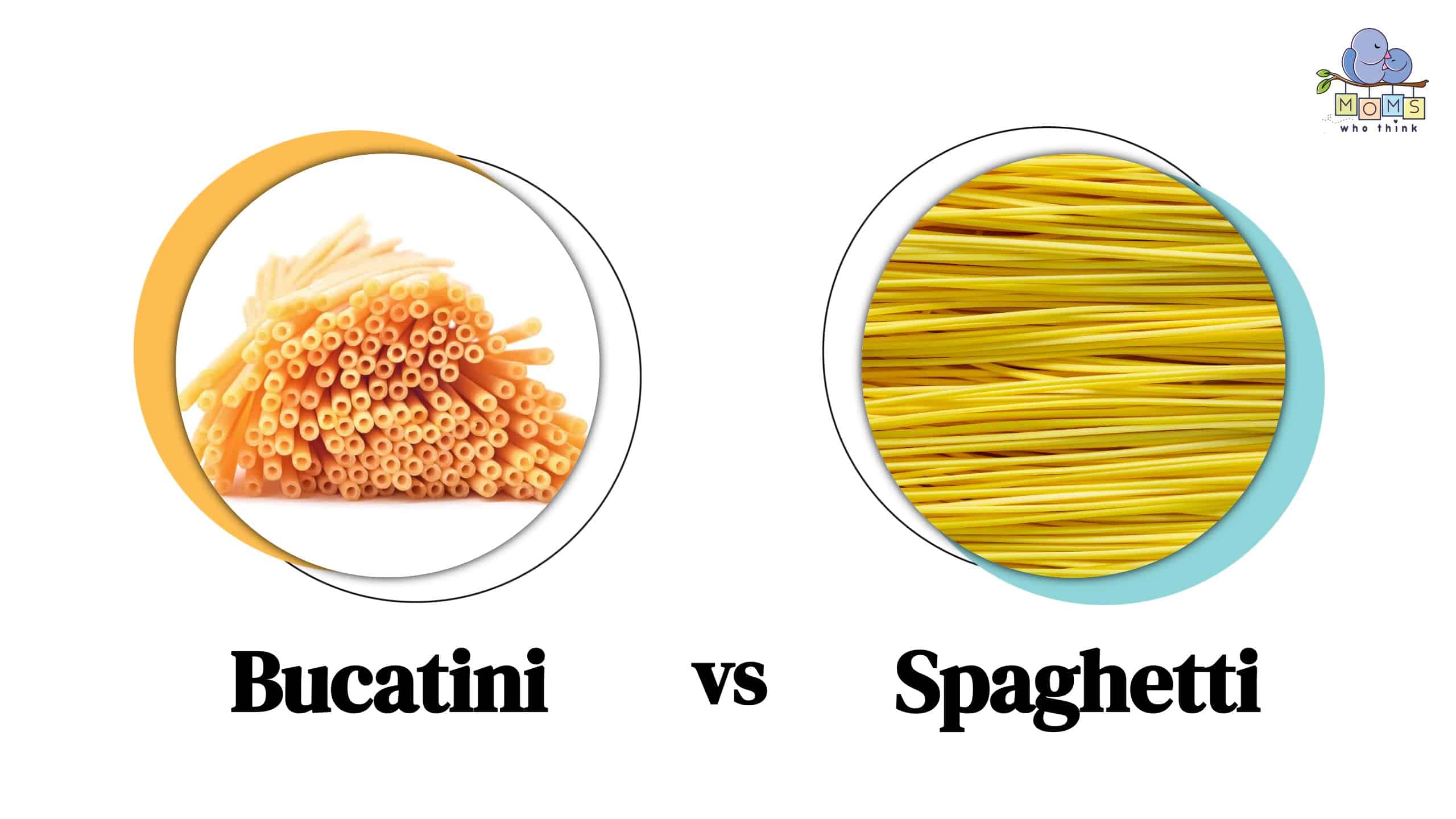Have you ever wondered what the difference is between bucatini vs. spaghetti? Though both are long, there are some differences between the two. Bucatini is long and thick with a hollow tube in the middle. Spaghetti is long thin, solid, and circular.
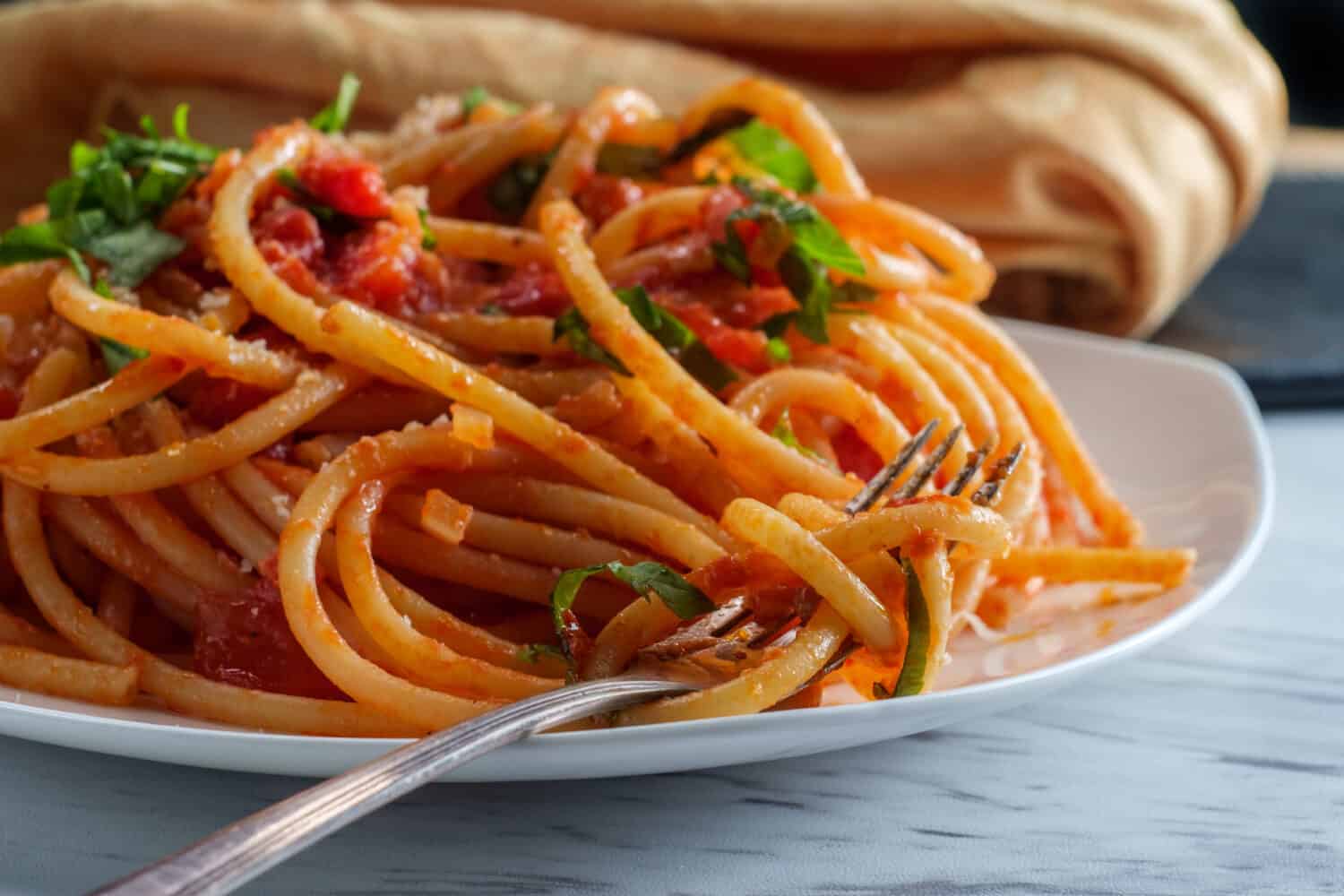
Bucatini amatriciana is a hearty and satisfying dish that is sure to please any pasta lover.
©Ezume Images/Shutterstock.com
Bucatini vs. Spaghetti: What is the Difference?
The primary difference between spaghetti and bucatini is that bucatini is thicker with a hole running through it while spaghetti is a solid noodle that's thinner.
Bucatini is made by squeezing the dough through bronze dyes, giving it a rough surface texture. The dough is forced through small holes, forming long noodles with a hole in the center. The difference in shape means that bucatini can hold up better with heavier sauces, such as carbonara or amatriciana, as the sauce can cling to the inside of the pasta.
On the other hand, spaghetti works well with lighter sauces such as olive oil-based sauce with vegetables or marinara. Additionally, bucatini can take longer to cook due to its thickness while spaghetti typically cooks quicker. Overall, it comes down to your personal preference and what type of dish you're making.
In this article, we will discuss the differences between bucatini vs. spaghetti. How each one is made, their texture, origin, flavor, and time to prepare. By understanding the key differences between bucatini vs. spaghetti, you can make an informative decision when choosing the right pasta for your next meal.
What is Bucatini?
Bucatini is a type of Italian pasta similar to spaghetti, it resembles a long thick hollow tube running through the center. It is usually made with durum wheat flour, a popular pasta in many parts of Italy and common in Rome. It is 25 – 30 centimeters in length and 3 millimeters wide. The average cooking time is 10 -11 minutes. It is usually served in a sauce and is often used in dishes such as bucatini amatriciana, which includes a tomato sauce, bacon, and grated Pecorino romano cheese. Bucatini is a great way to add texture and flavor to any dish. Pecorino romano cheese is an Italian cheese made from 100% sheep’s milk. Compared to parmesan cheese, pecorino romano is sharper and widely used. It is a great choice for an easy and flavourful meal.
Sauces that pair well with Bucatini
Bucatini is better for heavier sauces and vegetables, the hollow center allows the sauce to cling better to the pasta. Here are some great sauce ideas for preparing this irresistible long pasta.
- Bucatini with butter-roasted tomato sauce
- Amatriciana
- Silky tomato and cream sauce
- Bucatini with roasted cauliflower, brussels sprouts, and peppers
- Bucatini with green olives
- Creamy artichoke and bacon
- Shrimp and summer corn carbonara
- Italian-style mushroom ramen
- Chicken bucatini with creamy garlic, sun-dried tomato, and spinach sauce
- Bucatini with ricotta, lemon, and capers
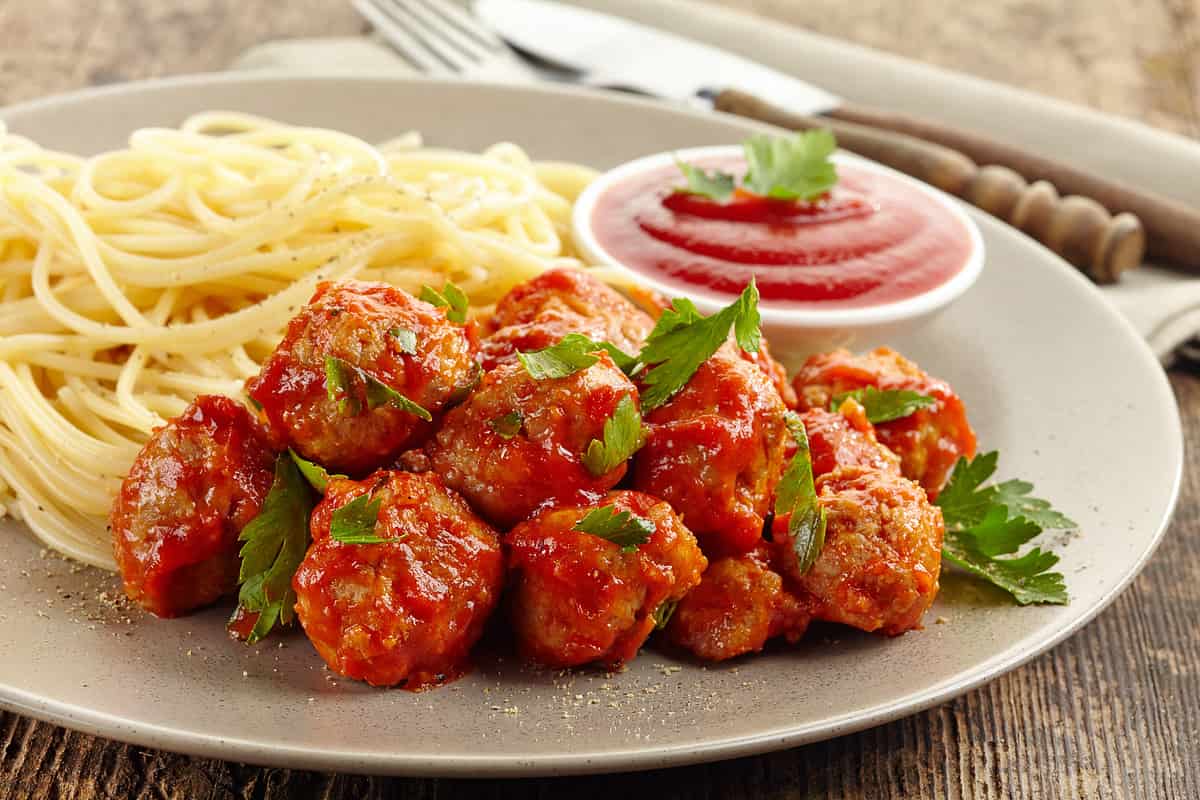
Spaghetti and meatballs is a popular dish in many households and can be easily customized to suit individual tastes.
©iStock.com/Magone
What is Spaghetti?
Spaghetti, on the other hand, is a long, thin, and solid strand that is perfect for lighter sauces. Its simple shape means that it doesn't overpower the sauce and lets all the flavors shine through. Spaghetti is also great for cold summer dishes, for example, pasta salads. Like bucatini, it is 25 – 30 centimeters in length and 1.8 – 2 millimeters wide. It usually takes eight minutes to cook.
Sauces that pair well with Spaghetti
Spaghetti is a classic beloved dish that has been a staple in households for generations. It is simple to make, versatile, and delicious, but what brings spaghetti to life is the sauce. Below is a list of easy sauces you can make to create a delicious midweek meal that the whole family will enjoy.
- Classic marinara sauce
- Bolognese sauce
- Alfredo sauce
- Pesto sauce
- Spaghetti carbonara sauce
- Four cheese sauce
- Spaghetti cacio e pepe
- Spaghetti alla gricia
- Clam sauce
- Creamy bacon spaghetti
Origins and Cultural Significances
Both bucatini and spaghetti originated in Italy, but they have different cultural significance. Bucatini has been a staple in Italian cuisine for centuries, especially in Rome. It's a common ingredient in traditional Roman dishes, such as amatriciana and gricia. The town of Amatrice in Italy is credited with inventing the famous amatriciana sauce that pairs perfectly with bucatini. The first amatriciana restaurant opened in a city near Piazza Navona in 1860 and was called IL Passetto.
Spaghetti is a symbol of Italian food culture and is often associated with Italian-American cuisine. Although it's a popular ingredient in many traditional Italian dishes, such as spaghetti alle vongole, it has become a household name for all things Italian in the United States. Spaghetti and meatballs, anyone? It is believed that spaghetti originated in the southern Italian region of Campania. Initially made from durum wheat flour, water, and salt, and was traditionally dried in the sun or hung on wooden poles. Spaghetti gained popularity during the 19th century as farmers started growing more wheat and exporting it to other regions in Italy.
Nutritional Value and Health Benefits
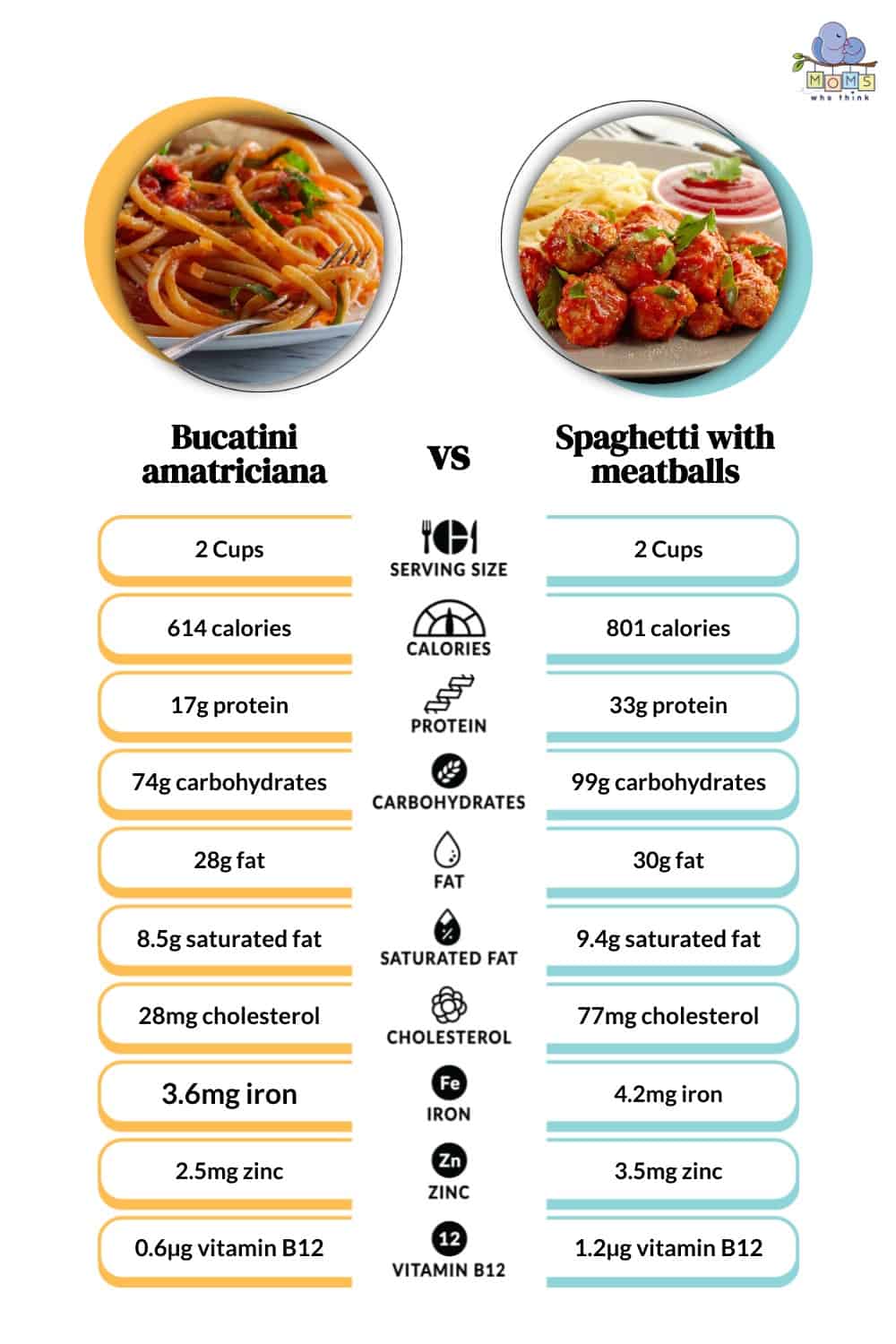
Bucatini amatriciana and spaghetti with meatballs nutritional comparison
©
According to nutritionix bucatini and spaghetti have different nutritional values and health benefits. In the chart below we will compare the nutritional values of bucatini amatriciana and spaghetti with meatballs based on 1 serving size about 2 cups. Based on the chart below bucatini amatriciana is a healthier dish containing fewer calories.
| Nutritional Facts | Bucatini amatriciana | Spaghetti with meatballs |
|---|---|---|
| Calories | 614 | 801 |
| Total Fat | 28g | 30g |
| Saturated Fat | 8.5g | 9.4g |
| Trans Fat | 0g | 0.7g |
| Polyunsaturated Fat | 3.7g | 5.5g |
| Monounsaturated Fat | 14g | 11g |
| Cholesterol | 28mg | 77mg |
| Sodium | 1506mg | 1335mg |
| Total Carbohydrates | 74g | 99g |
| Dietary Fiber | 8.4g | 9.7g |
| Sugars | 8.2g | 12g |
| Protein | 17g | 33g |
| Potassium | 593.3mg | 872.5mg |
Availability and Price Points
When it comes to availability and price, bucatini and spaghetti have some notable differences. Bucatini is not commonly found in supermarkets and specialty stores, making it more challenging to find. It's also often pricier than spaghetti due to its unique shape. Spaghetti is one of the most widely available pasta shapes. You can find it in most supermarkets, and it's one of the most affordable pasta shapes.
The Verdict: Bucatini vs. Spaghetti
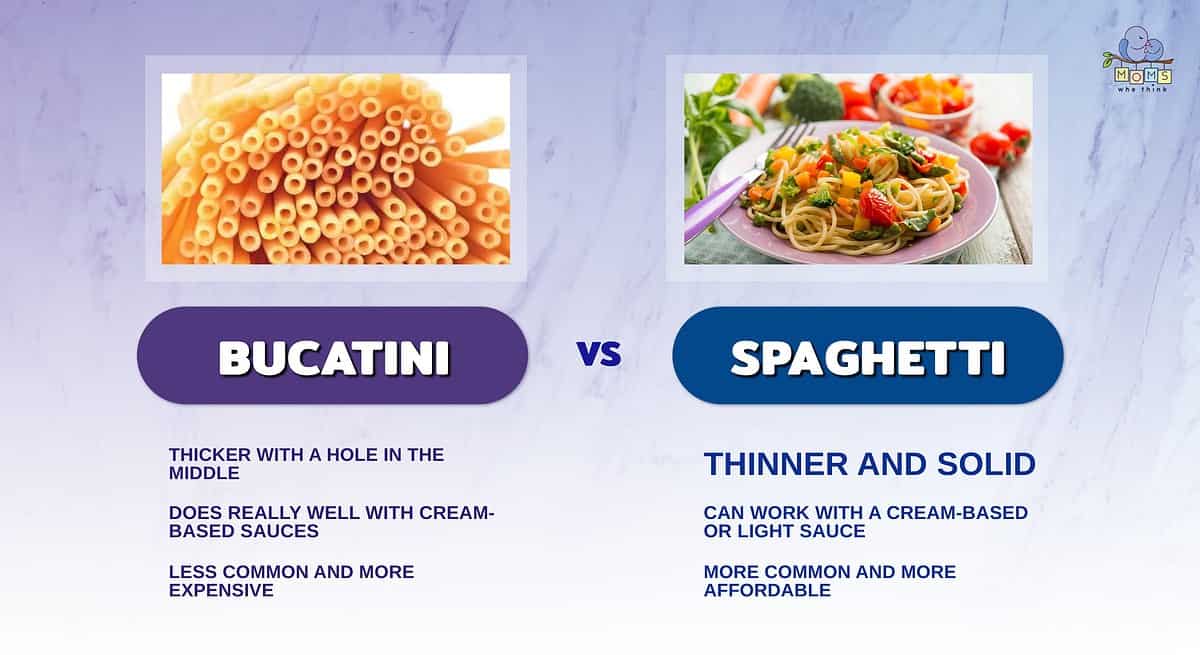
- Bucatini is thicker than spaghetti, with a hole through the middle. This makes it very easy to recognize!
- Since it's so thick, bucatini is best when paired with creamy sauces. Spaghetti can also blend well with a cream-based sauce, but light sauces can work well with this pasta as well.
- Bucatini isn't too common, and it tends to be more expensive. Spaghetti, on the other hand, is a cheap and readily available pasta.
Ultimately, the choice between bucatini and spaghetti comes down to the dish you're preparing and your taste. While bucatini may be ideal for thicker sauces and chunky ingredients, spaghetti is better for lighter toppings and simple sauces. Both pasta shapes have unique qualities that make them a worthwhile addition to any kitchen. Again, whether you prefer the thicker, hollow shape of bucatini or the thin, solid form of spaghetti, both are delicious in their own way. Each pasta type has its unique set of strengths, and choosing between the two often comes down to your personal preference and the type of dish you're making. Whatever you decide, we hope this article has provided you with valuable information about the world of pasta and will inspire you to try out new recipes and cooking techniques.
FAQ
Is bucatini healthier than spaghetti?
In fact, bucatini and spaghetti have similar nutritional profiles, with both being high in carbohydrates and low in fat. However, bucatini may be slightly higher in calories due to its thicker, more dense shape.
Can I use bucatini and spaghetti interchangeably in recipes?
You can certainly experiment with the two, it's important to keep in mind that their unique shapes and textures can affect the overall dish. Spaghetti is ideal for lighter sauces and simple toppings whereas bucatini is best paired with thicker sauces and chunkier ingredients.
Why is bucatini more expensive than spaghetti?
Bucatini is less common and often harder to find than spaghetti, which can drive up its price. Additionally, its thicker, more complex shape requires more time and effort to produce, adding to the cost.
Spaghetti Recipes
PrintEasy Spaghetti and Meatballs
Ingredients
- 1 pound ground beef
- 2 Tablespoons water
- 1/3 seasoned dry bread crumbs
- 1 egg, beaten
- 24 ounces (1 jar) Italian spaghetti sauce
- 8 ounces spaghetti, Cooked and drained
Instructions
1. Mix thoroughly ground beef, water, bread crumbs and egg.
2. Shape firmly into 12 (2-inch) meatballs. Arrange the meatballs in a 2-quart microwavable baking dish.
3. Microwave on HIGH for 5 minutes or until they're Cooked through. Drain excess fat.
4. Stir the sauce into the dish. Cover.
5. Microwave for 3 minutes or until hot. Serve over the spaghetti.
